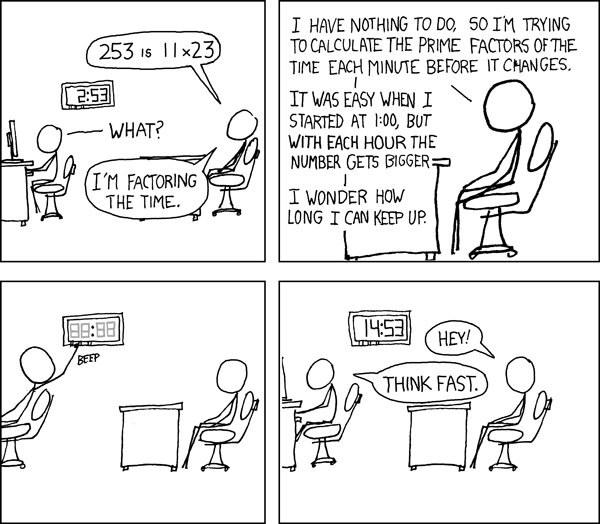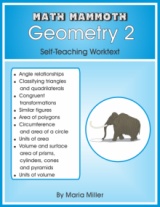I stumbled upon this comic that you might enjoy... factoring the time (from xkcd.com).
Jumat, 27 Agustus 2010
Selasa, 24 Agustus 2010
Carnival time: Math Teacher's at Play
Head on over to Math Teachers At Play #29 carnival to read a nice assortment of posts on math education!
Kamis, 19 Agustus 2010
Math tricks by a silly guy
A short youtube video where Kjartan Poskitt shows some math tricks. He's funny! Enjoy!
Jumat, 13 Agustus 2010
The equal sign problem
An interesting piece of research has just come out on the misconceptions with the equal sign (=).
Students' understanding of the equal sign not equal
According to the research, US students exhibit this misconception much more often than students in other countries. It has to do with thinking of the = sign as an operator. Kind of like thinking that = means "to do" the operation.
For example, a student with that misconception tends to solve the problem
7 + 6 = ____ + 2
by adding 7 + 6, and placing the answer on the empty line.
The correct way is of course to think of the equality: 7 + 6 equals 13, so the other side has to equal 13 too. 11 fulfills this little equation:
7 + 6 = 11 + 2
I have known of this problem for years, and have tried to include problems in my Math Mammoth books to help children NOT to develop this wrong idea. For example, children solve
200 + 50 + 6 = ____ + 200 + 50 in the place value section.
Or, I use problems where they have to put either <, >, or = in between (one the line here, but I like to use boxes in the books):
20 + 9 _______ 90 + 2
8 + 6 ________ 7 + 7
Or, just simple missing addend problems from the very start (1st grade):
3 + _____ = 5.
Remember, students exhibiting the misconception would add 3 and 5, and put 8 on the empty line. But we can teach kids to think of this problem as "3 and how many more makes 5". It is a starting point in understanding the equal sign in the correct way.
Then they should also (later on) encounter the same problem this way:
5 = ____ + 3
And other variations.
Students' understanding of the equal sign not equal
According to the research, US students exhibit this misconception much more often than students in other countries. It has to do with thinking of the = sign as an operator. Kind of like thinking that = means "to do" the operation.
For example, a student with that misconception tends to solve the problem
7 + 6 = ____ + 2
by adding 7 + 6, and placing the answer on the empty line.
The correct way is of course to think of the equality: 7 + 6 equals 13, so the other side has to equal 13 too. 11 fulfills this little equation:
7 + 6 = 11 + 2
I have known of this problem for years, and have tried to include problems in my Math Mammoth books to help children NOT to develop this wrong idea. For example, children solve
200 + 50 + 6 = ____ + 200 + 50 in the place value section.
Or, I use problems where they have to put either <, >, or = in between (one the line here, but I like to use boxes in the books):
20 + 9 _______ 90 + 2
8 + 6 ________ 7 + 7
Or, just simple missing addend problems from the very start (1st grade):
3 + _____ = 5.
Remember, students exhibiting the misconception would add 3 and 5, and put 8 on the empty line. But we can teach kids to think of this problem as "3 and how many more makes 5". It is a starting point in understanding the equal sign in the correct way.
Then they should also (later on) encounter the same problem this way:
5 = ____ + 3
And other variations.
Rabu, 11 Agustus 2010
Math Mammoth Geometry 2
I have just finished writing the material for Math Mammoth Geometry 2 book. The material in it is suitable for grades 6-7. Download price is $5.80.
The main topics in the book include:
* angle relationships
* classifying triangles and quadrilaterals
* angle sum of triangles and quadrilaterals
* congruent transformations, including some in the coordinate grid
* similar figures, including using ratios and proportions
* review of the area of all common polygons
* circumference of a circle (Pi)
* area of a circle
* conversions between units of area (both metric and customary)
* volume and surface area of common solids
* conversions between units of volume (both metric and customary)
* some common compass-and-ruler constructions.
I've included several complete lessons from the book as samples (PDF). Feel free to download these and use with your students!
Angles in Polygons
Review: Area of Polygons, 1
Surface Area
Besides those, there are two other sample pages:
Area and Perimeter Problems
Basic Compass and Ruler Constructions, 1
What is next?
The main topics in the book include:
* angle relationships
* classifying triangles and quadrilaterals
* angle sum of triangles and quadrilaterals
* congruent transformations, including some in the coordinate grid
* similar figures, including using ratios and proportions
* review of the area of all common polygons
* circumference of a circle (Pi)
* area of a circle
* conversions between units of area (both metric and customary)
* volume and surface area of common solids
* conversions between units of volume (both metric and customary)
* some common compass-and-ruler constructions.
I've included several complete lessons from the book as samples (PDF). Feel free to download these and use with your students!
Angles in Polygons
Review: Area of Polygons, 1
Surface Area
Besides those, there are two other sample pages:
Area and Perimeter Problems
Basic Compass and Ruler Constructions, 1
What is next?
Senin, 09 Agustus 2010
Review of Harold Jacobs Geometry
I have just posted a comprehensive review of this book that is popular among homeschoolers for a high school geometry course. Click to read:
Review of Harold Jacobs Geometry book
Review of Harold Jacobs Geometry book
Rabu, 04 Agustus 2010
Math assessment and placement
My daughter just completed the end-of-year math test for 4th grade. She scored 82%. She missed doing one question (just forgot), made a few careless mistakes, and then missed several in the measuring unit section because she didn't remember how many ounces are in a pound or how many grams in a kilogram. So we need to review some of that.
But overall, I am happy with the results, because (and I knew this beforehand too) she understands the concepts well! That is the most important thing. It's always easy to review some forgotten facts (such as measuring units), but when child has not understood the main concepts, the "patch-up" work is more tedious.
I have provided these Math Mammoth end-of-year tests on my site as free downloads so that people can use them as placement tests or for general math assessment. I often have people email me about their kids' results, and based on that, I feel those tests are working fine.
I have also collected a few other math assessment resources on this page, notably the yearly tests from Texas, Florida, and California (which are free) and a few commercial resources. Note: in my opinion, California's math standards are a bit too advanced, so use care when using their tests.
Some parents are against testing, but I feel testing for assessment is often needful in order to know what the child knows and doesn't know. The tests are like a "diagnostic toolbox" for me when I need to guide parents in what Math Mammoth books they might need for their children. So the purpose is not to "put on the pressure", but just to find out.
But overall, I am happy with the results, because (and I knew this beforehand too) she understands the concepts well! That is the most important thing. It's always easy to review some forgotten facts (such as measuring units), but when child has not understood the main concepts, the "patch-up" work is more tedious.
I have provided these Math Mammoth end-of-year tests on my site as free downloads so that people can use them as placement tests or for general math assessment. I often have people email me about their kids' results, and based on that, I feel those tests are working fine.
I have also collected a few other math assessment resources on this page, notably the yearly tests from Texas, Florida, and California (which are free) and a few commercial resources. Note: in my opinion, California's math standards are a bit too advanced, so use care when using their tests.
Some parents are against testing, but I feel testing for assessment is often needful in order to know what the child knows and doesn't know. The tests are like a "diagnostic toolbox" for me when I need to guide parents in what Math Mammoth books they might need for their children. So the purpose is not to "put on the pressure", but just to find out.
Langganan:
Postingan (Atom)

